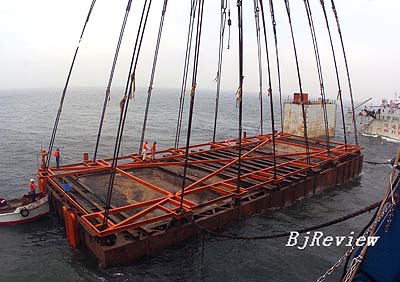|

You may know the Silk Road, a trade route from west China to the continents of Europe and Africa since China's Han Dynasty (206 B.C.-220) that got its name from the export of China's silk. But have you ever heard of a silk road on the sea, which can be dated back even further than the overland one?
A wreck that had been buried underwater for 800 years was recently raised from the seabed of the South China Sea, providing forceful evidence of the existence of an ancient maritime trade route connecting China and the rest of the world, archaeologists say.
In a huge steel cage as high as a three-story building and larger than a basketball court, the sunken ship, covered in mud, was hoisted onto a barge on December 22, 2007.
Named Nanhai 1, the ship was discovered in 1987 off the coast of South China's Guangdong Province, two meters under the surface of the silt at the bottom of the sea at a depth of 30 meters.
The wooden vessel, which is around 30 meters long and over 9 meters wide, is a merchant ship built in the latter part of China's Song Dynasty (960-1279). It is the oldest, largest and also the most complete ocean-going ship that has ever been recovered in the world, China's Xinhua News Agency said.
Archaeological value
In the past 20 years, archaeologists have excavated over 4,000 gold, silver and porcelain containers from the ship, as well as some 6,000 copper coins of the Song Dynasty. It is estimated that there were between 60,000 and 80,000 treasures altogether in the vessel.
According to Wei Jun, Vice Director of the Underwater Archaeology Research Center of the Institute on Archaeology of Guangdong Province, based on the current excavation and research, the majority of the relics on the Nanhai 1 are porcelains of over 30 varieties and most of them are well preserved.
"They will be valuable tangible evidence for research on the porcelain of the Song Dynasty," said Wei.
Apart from the porcelains and ancient coins, some ornaments and things for daily life have been discovered in the shipwreck, including gold bracelets, gold waistbands and copper mirrors, which historians think are also of great significance to the research on the life of people 800 years ago.
The ship also provides typical sample of ship building skills in the Song Dynasty and the preservation of wooden relics. Experts say that the Song Dynasty and the later Yuan Dynasty (1271-1368) was a time when China's ship-making skills developed rapidly, and ships made at that time were widely equipped with compasses and other advanced navigation instruments.
"Despite erosion in the seawater for over 800 years, the main body of Nanhai 1 has surprisingly been preserved pretty well, and the wood is still very solid. This is unprecedented in the world," said Wei.
More significantly, the salvaged ancient vessel is believed to be important evidence of the existence of a marine silk road connecting China with Southern Asia, Africa and Europe. It is recorded in historical books and documents that since the Han Dynasty, or even earlier, businessmen in central and east China shipped porcelains, clothes, silk and other goods made in China to other countries through an ocean route. The merchant ships usually set off from ports in south China's Fujian and Guangdong provinces, and would arrive in Egypt and Rome via India.
The marine silk road, like the better-known overland silk road stretching from Central Asia to Europe, became a bridge that linked Eastern and Western civilizations in the past. But, so far, the evidence that has been found to prove its existence has been rare, experts say.
Cautious research
Although the ancient ship was pulled out of the sea successfully, with the whole vessel and the relics on it intact, preserving them and carrying out further research on land will be a tough job.
At a press conference on the salvage of Nanhai 1 held on December 21, 2007, Chinese archaeologists said that they would be cautious about removing the ship's covering of mud. During its time in the sea the ship adapted to its ocean environment. Opening it rashly in the open air could lead to the destruction of the ship and its contents, according to Wei.
With this in mind, Nanhai 1 is now stored in a newly built glass museum, in an artificial environment similar to the one that it was hauled from on the ocean bed.
The scientists in the Guangdong-based Sun Yat-Sen University carried out an in-depth report on the environment of the sunken ship, based on which technicians worked out the exact environment for preserving the vessel, said Wei.
China will also invite foreign scientists in relevant fields to participate in the protection and archaeological research of Nanhai 1, said Shan Jixiang, Director of the State Administration of Cultural Heritage.
Archaeologists will do excavation and research on Nanhai 1 within its new glass home that contains seawater to a depth of 12 meters. Visitors to the museum will be able to watch the archaeological research as it happens. The museum, called Crystal Palace by locals, will be open to the public at the end of 2008.
The true face of the Nanhai 1 will not be unveiled for another five to 10 years, said Wei. And perhaps the Nanhai 1 will lead archaeologists to further discoveries, like who owned it, where they were heading, and whether there are more ocean silk road ships at the bottom of the sea? |